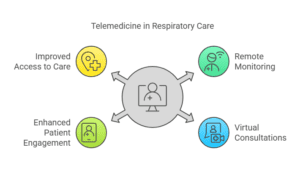Respiratory illnesses, such as asthma, chronic obstructive pulmonary disease (COPD), pneumonia, and bronchitis, affect millions of people worldwide and can lead to severe health complications. Effective management of respiratory conditions often requires ongoing monitoring, timely interventions, and consistent communication between patients and healthcare providers. Telemedicine has emerged as a transformative tool in the management of respiratory illnesses, offering patients more accessible care, reducing hospital visits, and improving overall disease management.
Let’s explore how telemedicine plays a crucial role in managing respiratory illnesses, enhancing patient care, and improving health outcomes.
Why Telemedicine is Essential in Managing Respiratory Illnesses
Respiratory diseases often require frequent follow-ups, ongoing medication management, and real-time monitoring of symptoms, which can be challenging for both patients and healthcare providers. Telemedicine offers an efficient solution by enabling remote consultations, continuous monitoring, and more timely interventions. Key benefits of telemedicine for respiratory illness management include:
- Access to specialists: Telemedicine allows patients to consult pulmonologists and other specialists remotely, improving access to expert care.
- Timely interventions: Through real-time consultations, telemedicine enables healthcare providers to adjust treatment plans and medications without delay.
- Remote monitoring: Telemedicine facilitates continuous monitoring of symptoms, reducing the need for in-person visits and preventing exacerbations.
How Telemedicine Helps in Managing Respiratory Illnesses

1. Remote Monitoring of Symptoms
For patients with chronic respiratory conditions, such as asthma or COPD, continuous monitoring is critical to detect early signs of worsening symptoms. Telemedicine enables real-time monitoring through wearable devices and home monitoring tools. Key benefits include:
- Monitoring lung function: Devices like portable spirometers or pulse oximeters can transmit data to healthcare providers, allowing for remote monitoring of lung function and oxygen levels.
- Tracking symptoms: Patients can report symptoms like coughing, wheezing, or shortness of breath through telemedicine platforms, helping physicians assess changes in condition.
- Proactive care: Continuous monitoring allows healthcare providers to intervene early, preventing acute episodes and reducing the risk of hospitalizations.
2. Virtual Consultations with Healthcare Providers
Telemedicine allows patients to connect with healthcare providers via video calls or messaging platforms for consultations, making it easier to manage respiratory illnesses without frequent in-person visits. Benefits of virtual consultations include:
- Convenience and accessibility: Patients can access their healthcare provider from home, saving time and reducing the need for travel, especially in cases of limited mobility or severe symptoms.
- Improved access to specialists: Telemedicine helps patients in rural or underserved areas consult with pulmonologists or other specialists who may not be locally available.
- Treatment adjustments: Physicians can assess the patient’s symptoms and adjust medications or treatment plans based on real-time feedback, ensuring optimal management of respiratory conditions.
3. Medication Management and Adherence
Patients with respiratory conditions often require multiple medications, such as bronchodilators, corticosteroids, or oxygen therapy. Telemedicine plays a role in managing medications by:
- Remote prescription management: Physicians can remotely prescribe medications, ensuring patients have access to their necessary treatments without needing an in-person visit.
- Medication reminders: Telemedicine platforms can send reminders for medication refills and help patients stay on track with their treatment regimens.
- Monitoring side effects: Telemedicine allows healthcare providers to track any side effects or complications related to medications, adjusting dosages or switching medications as needed.
4. Lifestyle Counseling and Education
Lifestyle changes, including smoking cessation, exercise, and environmental control, are key components of managing respiratory illnesses. Telemedicine enables healthcare providers to deliver counseling and education remotely. Benefits include:
- Providing educational resources: Telemedicine platforms can offer videos, articles, or interactive tools to help patients understand their conditions, treatments, and preventive measures.
- Counseling on smoking cessation: Patients can receive virtual counseling sessions on quitting smoking, a crucial factor in managing COPD and other respiratory diseases.
- Promoting physical activity: Healthcare providers can recommend exercise programs tailored to the patient’s condition, helping to improve lung function and overall well-being.
5. Early Detection and Intervention
Telemedicine allows for early detection of exacerbations or worsening symptoms, enabling quicker interventions that can prevent hospitalizations. Key benefits include:
- Timely alerts: Healthcare providers can monitor patient-reported symptoms and vital signs in real time, triggering immediate interventions when necessary.
- Minimizing emergency visits: By addressing issues before they escalate, telemedicine reduces the need for emergency room visits and hospitalizations, ensuring better management of respiratory illnesses.
- Personalized care: Telemedicine allows healthcare providers to tailor care plans based on ongoing remote monitoring, ensuring that treatment is always aligned with the patient’s current condition.
6. Managing Respiratory Infections
Respiratory infections, such as pneumonia or bronchitis, can quickly become serious in patients with chronic respiratory diseases. Telemedicine helps manage these infections by:
- Remote diagnosis: Physicians can assess symptoms like cough, fever, and shortness of breath through virtual consultations and decide if further diagnostic tests or treatment are necessary.
- Monitoring recovery: After diagnosing a respiratory infection, telemedicine allows physicians to monitor recovery, adjust treatment if symptoms worsen, and prevent complications.
- Preventive care: Telemedicine helps healthcare providers offer guidance on preventive measures, such as flu vaccinations, to reduce the risk of respiratory infections.
7. Reducing Hospital Readmissions
For patients with severe respiratory conditions, frequent hospital readmissions can be a challenge. Telemedicine reduces the likelihood of readmissions by ensuring continuous monitoring and timely intervention. Benefits include:
- Follow-up care: After a hospitalization or acute episode, telemedicine allows for easier follow-up consultations, ensuring patients continue to receive care and recovery guidance.
- Home-based monitoring: Remote monitoring tools ensure that healthcare providers can track patients’ progress after discharge, reducing the risk of readmissions.
- Patient engagement: By providing patients with continuous support and education, telemedicine improves adherence to treatment plans and enhances overall disease management.
Conclusion
Telemedicine is revolutionizing the management of respiratory illnesses by providing remote monitoring, virtual consultations, medication management, and lifestyle counseling. These innovations not only enhance the quality of care but also improve access, reduce hospitalizations, and support patient engagement. As telemedicine continues to evolve, it will play an increasingly vital role in managing chronic respiratory conditions and improving patient outcomes.
What People Are Asking
1. How does telemedicine help manage respiratory illnesses?
Telemedicine enables remote monitoring of symptoms, virtual consultations with healthcare providers, medication management, and ongoing lifestyle counseling, helping patients manage their respiratory conditions effectively.
2. Can telemedicine replace in-person visits for respiratory illnesses?
Telemedicine can supplement in-person visits by providing ongoing care, monitoring, and consultations remotely, reducing the need for frequent in-person visits while ensuring proper management of respiratory conditions.
3. How does telemedicine help with early detection of respiratory issues?
Telemedicine allows healthcare providers to monitor patient-reported symptoms and vital signs in real time, enabling early detection of exacerbations and providing timely interventions.
4. How does telemedicine improve medication adherence for respiratory patients?
Telemedicine platforms send medication reminders and allow for remote prescription management, ensuring that patients stay on track with their prescribed treatments.
5. Can telemedicine be used for managing respiratory infections?
Yes, telemedicine allows for remote diagnosis and monitoring of respiratory infections, reducing the need for in-person visits and helping to manage the condition effectively.
Disclaimer
For informational purposes only; not applicable to specific situations.
For tailored support and professional services,
please contact Staffingly, Inc. at (800) 489-5877
Email: support@staffingly.com.
About This Blog: This Blog is brought to you by Staffingly, Inc., a trusted name in healthcare outsourcing. The team of skilled healthcare specialists and content creators is dedicated to improving the quality and efficiency of healthcare services. The team passionate about sharing knowledge through insightful articles, blogs, and other educational resources.
 Book a Demo to Build Your Team Today!
Book a Demo to Build Your Team Today!

 Read Case Studies
Read Case Studies 


 Virtual Medical Assistants
Virtual Medical Assistants



